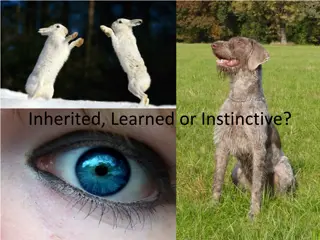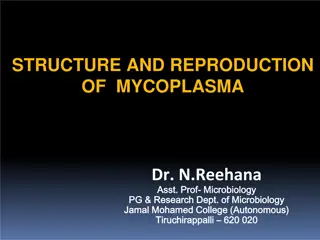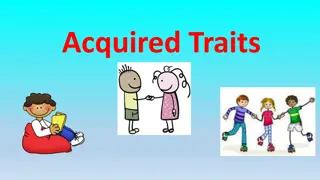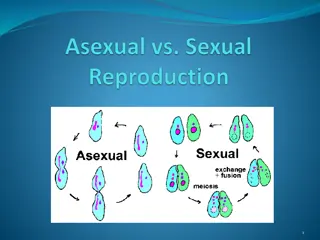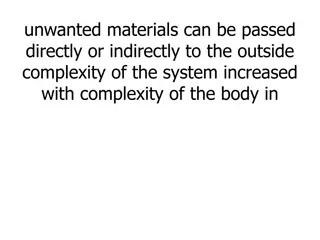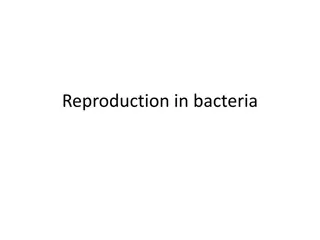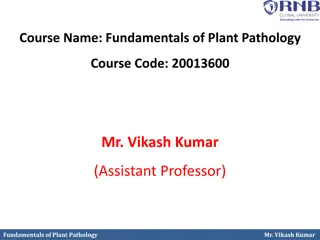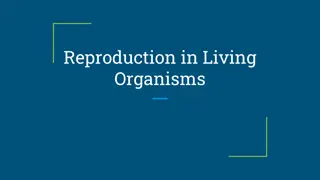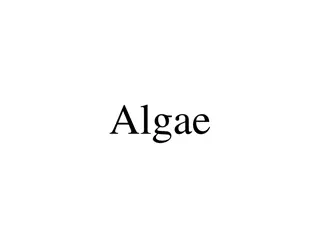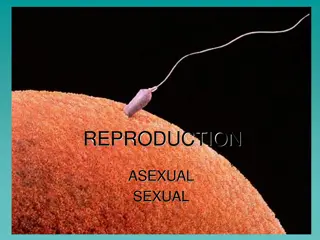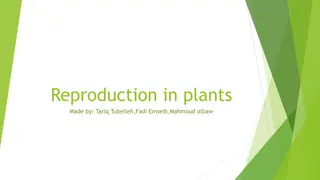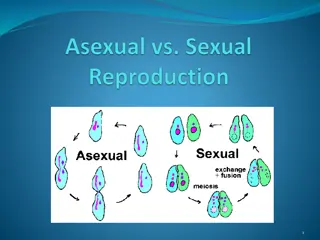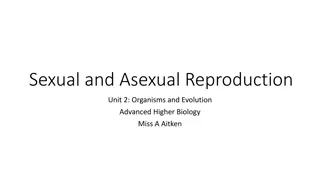Asexual Reproduction and Passing of Traits
Asexual reproduction involves cell division to create genetically identical offspring. This process includes binary fission, budding, fragmentation, and vegetative growth. Offspring produced through asexual reproduction inherit traits directly from the parent organism. Understanding asexual reproduction is essential for comparing and contrasting it with sexual reproduction, particularly in terms of trait inheritance.
Uploaded on Sep 25, 2024 | 2 Views
Download Presentation

Please find below an Image/Link to download the presentation.
The content on the website is provided AS IS for your information and personal use only. It may not be sold, licensed, or shared on other websites without obtaining consent from the author.If you encounter any issues during the download, it is possible that the publisher has removed the file from their server.
You are allowed to download the files provided on this website for personal or commercial use, subject to the condition that they are used lawfully. All files are the property of their respective owners.
The content on the website is provided AS IS for your information and personal use only. It may not be sold, licensed, or shared on other websites without obtaining consent from the author.
E N D
Presentation Transcript
Reproduction What s the difference in these two forms of reproduction?
Essential Question: How does asexual and sexual reproduction compare in the passing of traits to offspring? Standard: S7L3b. Compare and contrast that organisms reproduce asexually and sexually (bacteria, protists, fungi, plants and animals)
Reproduction Previously, you learned that cells make more cells through the process of Mitosis You learned that sex cells are created in a process called Meiosis You learned that adults produce offspring with the help of which system Reproductive System
For this unit, we will look at reproduction with a more specific focus on the passing of traits.
Asexual Reproduction Most unicellular organisms, and a few multicellular organisms use cell division (mitosis) to reproduce in a process called asexual reproduction. A parent organism(one parent only) produces one or more new organisms that are identical to the parent and live independently of the parent
Asexual Reproduction The organism that produces the new organism or organism is the parent Each new organism is an offspring The offspring produced by asexual reproduction are genetically identical to the parent.
Asexual Reproduction 1.Binary Fission is when parent cell splits into two identical cells, occurs in cells that do not contain a nucleus (Prokaryotes)
Asexual Reproduction 2.Budding grows another organism that falls off when mature, occurs in hydra (fresh water animal)
Asexual Reproduction 3.Fragmentation creates a new organisms from a part of an organism, occurs in starfish
Asexual Reproduction 4. Vegetative grows an identical plant from another, occurs in potatoes and African Violets
Sexual Reproduction Reproduction when two parent cells (male and female reproductive cells) combine to form offspring with genetic material from both cells.
A Eukaryotic cell has a Nucleus that contains genetic material. A Chromosome is the structure that holds the genetic material (DNA). specific traits. A Gene is a section of DNA that provides instructions for Heredity is the passing of Genes from parents to offspring. material that provides instructions for all the body s functions. DNA is the genetic
Sexual Reproduction Each species of living things has a characteristic number of chromosomes. Humans have 23 pairs, for a total of 46 chromosomes.
Sexual Reproduction Recall from our previous unit the cell process called Meiosis. What was the purpose of Meiosis? Make Sex Cells What was our general description of Meiosis? One Cell Makes Four Cells
Sexual Reproduction The process of Meiosis creates sex cells (sperm and egg in humans) that contain half the genetic material (half the 46 chromosomes) 46 Chromosomes During sexual reproduction, sex cells are combined to form unique offspring. 23 Chromosomes
Sexual reproduction in plants: Pollination: it is the transfer of pollen from one flower to the other. it is the first step in sexual reproduction in plants. Male part in plants: is called stamen Female part in plants: is called pistil During pollination the pollen from stamen reaches the pistil and fertilization takes place in ovary[ part of pistil. Insects and wind help in pollination.
Plant parts involved in sexual reproduction
Reproduction http://www.youtube.com/ watch?v=jk2RJm5RBEk https://www.youtube.com/ watch?v=2ycl2E9r-_o
Asexual & Sexual Reproduction Sorting Activity
Investigating Reproductive Strategies Activity
Summarizer: Comparing Asexual & Sexual Reproduction



